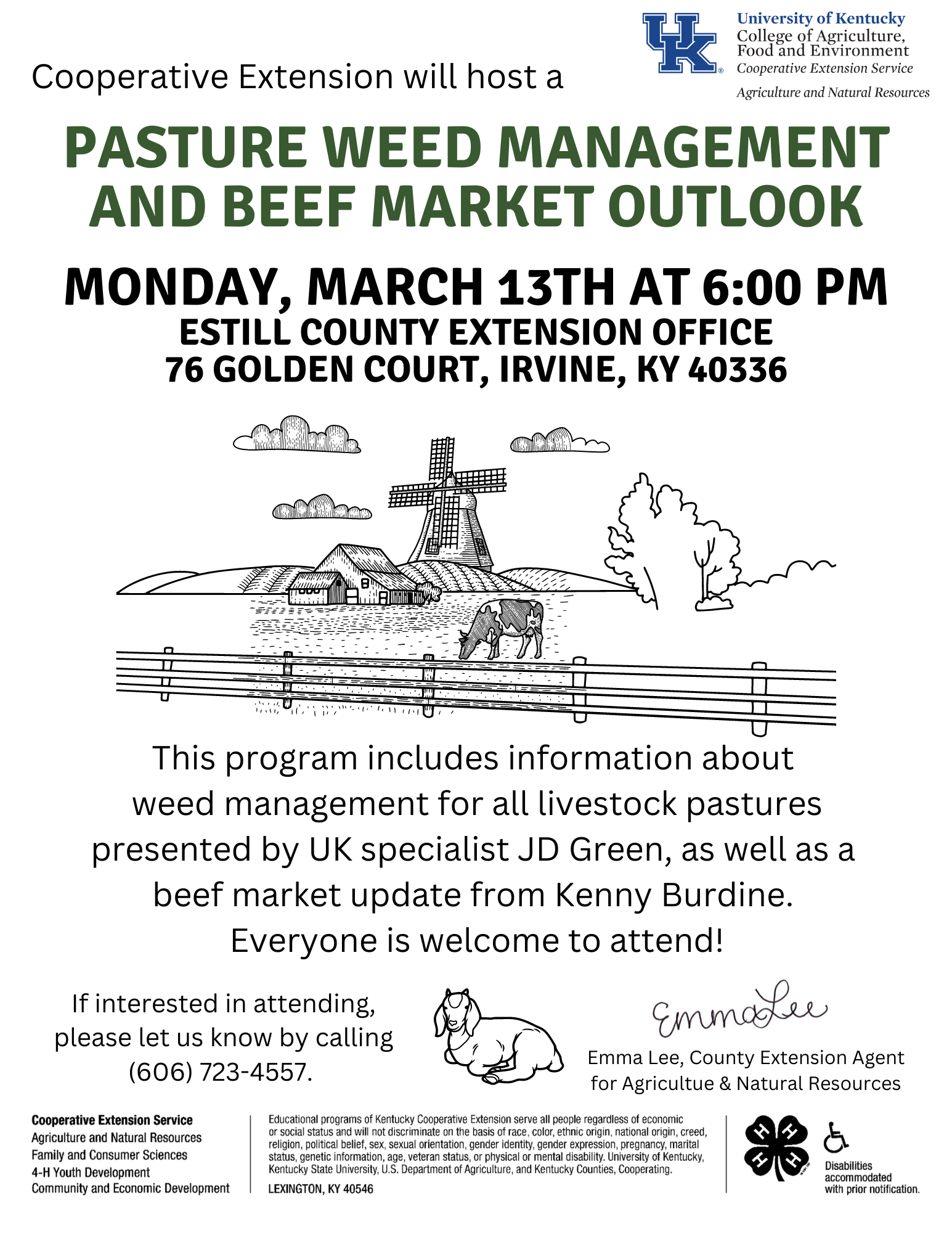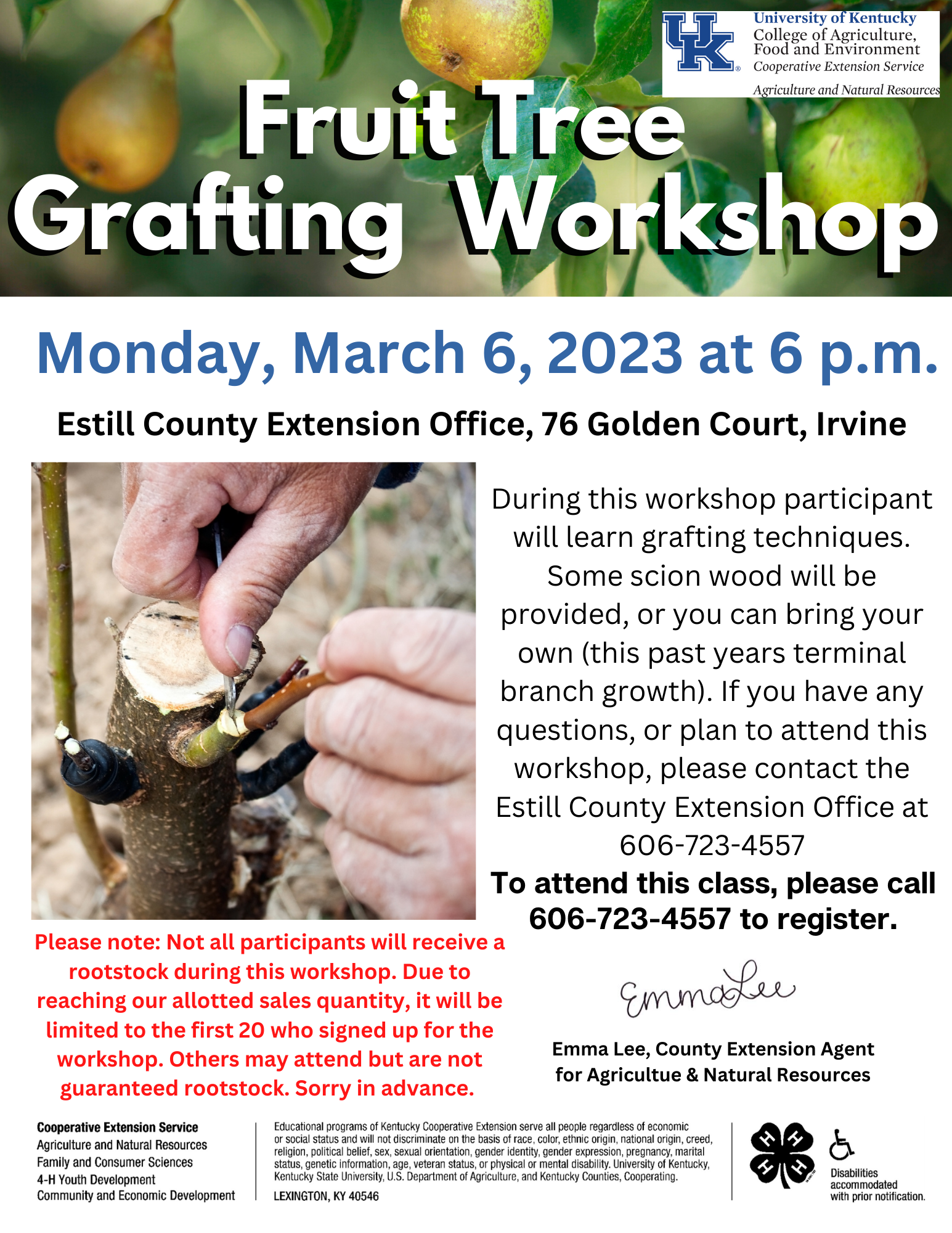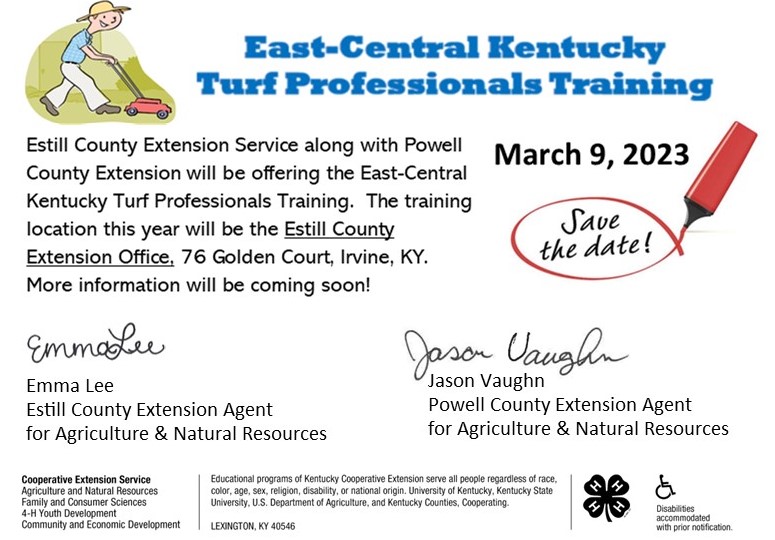Estill County Farm Scoop
February 2023 Edition
Agriculture & Natural ResourcesView Newsletter
Share this Newsletter
Additional Newsletters
Preview This Newsletter
Estill County Farm Scoop - Agriculture & Natural Resources
February 2023
Hello from the Agent:
Happy February everyone! This month at the Extension office, we are taking orders for our plant sale until March 3rd. There are different types of berries, asparagus, and onions available. Orders must be prepaid (cash or check only, no cards) before they will be submitted. For more information, visit our office or call us at (606) 723-4557.
For those interested in ordering and growing asparagus, there is a proper way to plant in order to have a successful harvest. Dig a 6-12 inch deep furrow (trench) for the crowns to be planted into. In heavy clay soils, make the furrows more shallow (6-8 inches) and deeper (10-12 inches) for very sandy soil. As the soil is removed from the trench, set it directly to the side. It will be returned to the trench several weeks later as the ferns grow.
The length of the trench should be as long as the number of crowns being planted. For example, if you have 10 crowns, dig a 10-foot long trench. If planting multiple rows, space the furrows at least 3 feet apart, because the plants will spread as they age. Adding a fertilizer containing phosphorus and potassium to the furrows at the time of planting will help make sure the plants can access adequate nutrients as they grow. Next, cover the crowns with 2-3 inches of the soil that was removed from the furrow previously. The rest of the remaining soil will be added to the trench a few weeks later, once the ferns have emerged and grown. Do not let the crowns dry out between placing them in the furrows and covering them with soil. Water immediately after planting.
After planting, there should still be plenty of soil along the sides of the furrows, which will be used later in the season to continue back-filling the furrows as the ferns grow. Small, narrow spears will start to emerge from the soil within 2-3 weeks of planting, depending on precipitation, temperature and amount of soil cover. Once the spears are sturdy and several inches tall, several more inches of soil can be back-filled into the furrow. Use caution with this step, as large clods of dry soil can break the brittle spears.
For more information visit https://extension.umn.edu/vegetables/growing-asparagus#starting-crowns-192561 or contact (606) 732-4557.
/s/ Emma Lee, County Extension Agent for Agriculture & Natural Resources
Cooperative Extension will host a Pasture Weed Management and Beef Market Outlook on Monday, March 13th at 6:00 p.m. at the Estill County Extension Office, 76 Golden Court, Irvine, KY 40336. This program includes information about weed management for all livestock pastures presented by UK Specialist J.D. Green, as well as a beef market update from Kenny Burdine. Everyone is welcome to attend. If interested in attending, please let us know by calling 606-723-4557.

Kentucky Department of Agriculture Nuisance Weed Spraying Program
This program consists of weed spraying demonstration plots. The department will provide the sprayer and enough chemical for the treatment of 10 acres of agricultural land or 100 gallons of spot spraying mix to be used on agricultural land. The department’s representative will demonstrate proper mixing and application techniques. A number of nuisance weeds can be treated under this program depending on the needs of the participant. This program is limited to broadleaf weeds.
Broadcast Spraying demonstration plots consist of:
· 10 acres of agricultural land will be treated with chemical provided by the department
· Application is performed with a two-wheeled trailer type sprayer equipped with boomless nozzles
If additional chemical is provided by the participant, an additional 10 acres can be treated
Spot Spraying demonstration plots consist of:
· 100 gallons of broadleaf chemical mix which is applied until sprayer is empty
· Application is performed with a two-wheeled trailer type sprayer equipped with a handheld spray wand used by the tractor operator
If additional chemical is provided by the participant, an additional 100 gallons can be sprayed
For each demonstration:
· The participant must provide water source
· The participant must provide tractor and operator
· All chemical products must be labeled and the product label will be strictly followed
A maximum of 7 participants per county
This program is designed to target weeds that have a negative impact on the participant’s agricultural production.
There will be an annual online application period to participate in this program. Applications can be completed from February 1 to February 29 at https://www.kyagr.com/consumer/nuisance-weed-spraying-program-application.aspx.
Take care of our feathered friends in winter
Source: Kelly Jackson, UK extension horticulture agent
Winter is a hard time for birds to find natural foods like wild cherries and dogwood and holly berries. We can help by putting out feeders filled with seed, along with suet, pine cones smeared with peanut butter and even fruit halves. It will help supplement their diet and provide enough food to get them through the winter.
Most birds will eat just about anything you put out, but there are some birds who have preferred foods. If you select the foods of birds that you want to see, then you will be less likely to get nuisance birds like starlings, grackles and crows. You are better off not to buy seed mixes as they contain peanut hearts, which are attractive to starlings. You will have better success if you buy black oil-type sunflower seed and white millet separately, in bulk. These are often cheaper than seed mixes too. Black oil sunflower seed will attract most seed-eating birds. Millet will attract sparrows, cowbirds and dark-eyed juncos.
Platform feeders will accommodate most birds. They can also lead to a lot of seed loss and waste, as the birds will knock the seed around and fall to the ground. If you want to attract specific birds, choose a feeder for that type bird. Gold and house finches prefer a tube feeder with a small opening for nyjer thistle or hulled sunflower seeds.
Don’t forget that birds need water too. Keep a bird bath or water source close to feeders, and be sure the water is fresh and not frozen, as it tends to freeze in winter. Place the feeders in an open area where there are deciduous and evergreen trees, with shrubs nearby, so birds can escape for shelter.
House cats can be a problem around bird feeders as they will lay in wait to ambush the birds for a meal. If you have a cat, consider putting a collar with a bell on it, so birds can escape before being attacked.
Keep your feeders clean by periodically using hot, soapy water and a capful of bleach to remove old, dried seed. Platform feeders might hold water and should have small holes drilled into the bottom to allow water to drain.
Contact the Estill County office of the University of Kentucky Cooperative Extension Service for information on feeding birds in winter.
Fruit Tree Grafting Workshop will be held Monday, March 6, 2023 at 6:00 p.m. at the Estill County Extension Office, 76 Golden Court, Irvine, KY 40336. During this workshop participants will learn grafting techniques. Some scion wood will be provided, or you can bring your own (this past years terminal branch growth). If you have any questions, or plan to attend this workshop, please contact the Estill County Extension Office at 606-723-4557.
*Please note: The flyer states that all participants will receive one rootstock. Due to reaching our allotted sales quantity, it will be limited to the first 20 who signed up for the workshop. Others may still attend but are not guaranteed a rootstock.

Start the year right with good record-keeping practices
Sources: Steve Isaacs, extension agricultural economist
Record-keeping is not everyone’s favorite activity, but with a little time, patience and a commitment to get it done, your financial life will be more peaceful.
Record-keeping tasks don’t have to be difficult. Think of it as a way to keep track of your operation that will help you make better long-term decisions. You can use a ledger book or a computer—whatever helps you maintain consistency. Software programs can help you make sense of your data.
Software has become more user-friendly over time, and while it may not make the record-keeping process fun, it could help you see the overall picture of your operation. Some programs track purchases and how you use each item on a particular enterprise or field. You’ll be able to keep track of repair and maintenance records for specific farm equipment and produce balance sheets, income statements and cash flow budgets.
For many livestock operations, a good time to start keeping records is when your veterinarian comes to check your animals. Vets usually charge per head, so that data can help you develop a list of animals that need attention. You can use the same data to develop health histories of your animals, which will lead to more informed exams and diagnoses in the future.
Make record-keeping a team effort for your family. Sit down and work on the records and budget together. Perhaps one person can read the information while another person types it into the software program or writes it in the ledger book. You won’t become overwhelmed if you do a little bit each day and don’t save it all up for the end of the year. Year-end procedures also can feel more satisfying if you’ve done the work throughout the year. You can generate year-end reports with a few simple clicks and not have to sort through stacks of bills lying around the home or office.
The University of Kentucky College of Agriculture, Food and Environment’s Department of Agricultural Economics has several tools online that could help with budgeting and decision-making. Visit https://agecon.ca.uky.edu/budgets to see what is available.
For more information about record-keeping and a variety of other farm management topics, contact the Estill County Cooperative Extension Service.
De-icing around your home
Source: Kelly Jackson, UK Extension Agent for Horticulture, Christian County
When winter storms are part of our forecast, we tend to think of all the possible hazards. Sometimes winter storms bring ice and snow that cover our sidewalks and driveways. Many people use deicers to help remove the slippery stuff, but how much is too much?
Following a few simple steps can help you stay safe while using fewer deicer products. Clear the necessary pathways of all snow. You can save time and energy by just shoveling the areas you need to get in and out of your house, greenhouse, barn, etc. Limit using deicer to the problem areas. You may only need a handful of product for a square yard. Be sure to read the product label for best practices, as products vary.
After the storm, sweep up any excess product to protect your lawn and local waterways. Experts suggest using more product is no more effective at clearing ice and snow. If you see salt crystals after the pathway is dry, that’s a sign you have used too much.
Using too much deicer is not just wasting financial resources. The chemicals in deicing products can enter our stormwater and eventually streams and nearby rivers. Excess chemicals can also cause your lawn and landscape shrubs to turn yellow. The chemicals may also damage sidewalks and landscape pavers. It’s a good idea to research native, salt-resistant plants for areas close to paved surfaces to keep your landscape looking nice in all seasons.
If you need help deciding on which deicer to use, the U.S. Environmental Protection Agency has a helpful resource at https://www.epa.gov/saferchoice/products that show deicers and other household products that are safer for human health and for the environment.
You can also try some deicer alternatives. Cracked corn may not be a deicer, but it can provide much-needed traction in slippery areas. Several other options, such as sand, fireplace ashes or cat litter may help increase traction and they do not require as much cleanup after the winter weather passes. A creative way to keep ice from covering problem areas like stairs is to cover them in heavy plastic before a storm begins.
For more information, contact the Estill County Cooperative Extension Service.
Educational programs of Kentucky Cooperative Extension serve all people regardless of economic or social status and will not discriminate on the basis of race, color, ethnic origin, national origin, creed, religion, political belief, sex, sexual orientation, gender identity, gender expression, pregnancy, marital status, genetic information, age, veteran status, or physical or mental disability.
To file a complaint of discrimination, contact Tim West, UK College of Agriculture, 859-257-3879; Terry Allen or Patty Bender, UK Office of Institutional Equity and Equal Opportunity, 859-257-8927; or the USDA, Director Office of Civil Rights, Room 326-W Whitten Bldg., 14th & Independence Ave. SW, Washington, DC 20250-9410 (202-720-5961).
Private Pesticide Applicator Trainings
There will be two (2) private pesticide certification training opportunities: Monday, February 27 at 6:00 p.m. or Tuesday, February 28 at 10:00 a.m. at the Estill County Extension Office, 76 Golden Court, Irvine, KY 40336.
A certified private pesticide applicator can purchase and use restricted-use pesticides to produce any agricultural commodity on property owned or rented by him/her or an employer, or to the lands of a farmer-neighbor, if the application is made without compensation other than trading of personal service between producers of agricultural commodities. Certified private applicators also may train workers to satisfy Worker Protection Standards. For more information or if you plan to attend this training, please call 606-723-4557 to pre-register.
East-Central Kentucky Turf Professionals
Estill County Extension Service along with Powell County Extension will be offering the East-Central Kentucky Turf Professionals Training on March 9, 2023. The training location this year will be the Estill County Extension Office, 76 Golden Court, Irvine, KY 40336. More information will be coming soon!


